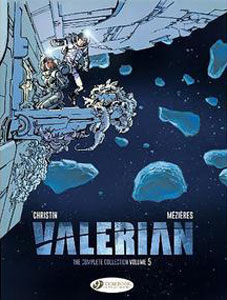Looking for a “Valerian” fix after last year’s movie, “Valerian and the City of a Thousand Planets,” I’m delving into the comics that started it all, by Frenchmen Pierre Christin (writer) and Jean-Claude Mezieres (pencils and inks). “The Complete Collection, Volume 5” includes “On the Frontiers” (1988), “The Living Weapons” (1990) and “The Circles of Power” (1994). These stories are collectively known as “The New Future Trilogy.”
Volume 13: “On the Frontiers” (1988)
We enter an era when Galaxity (the high-tech future Earth capital Valerian hails from) no longer exists, likely because of the timeline reset of the previous saga that wrapped with “The Wrath of Hypsis.” Lacking Spatio-Temporal Agency bosses and assignments, Valerian and Laureline likewise lack paychecks, so in this upcoming phase of books they take odd jobs.
Before we get to that, though, “On the Frontiers” takes the unusual tactic of opening with a long introduction to the antagonist, Jal, another Spatio-Temporal agent who has survived the timeline reset. In a scheme that makes no logical sense even within the context of imaginative sci-fi (but I guess it does in Jal’s troubled mind), Jal aims to jump-start worldwide nuclear war on this timeline (as happened on the old one), thinking that will make Galaxity exist in the future again.
So this is sort of a coda to “The Wrath of Hypsis” in addition to being an introduction to our heroes’ new reality. Although we don’t find out until quite a ways into the yarn, V&L’s sponsors on this mission – working through middleman Mr. Albert – are a UCLA professor and an Army man. They somehow know that Valerian and Laureline are valuable allies, although we don’t learn how they know that.
This isn’t necessarily a problem, since recent stories established a network of non-time-traveling Spatio-Temporal agents on Earth, so we can assume it has something to do with that. Also, Christin and Mezieres have simply built up so much goodwill with “Valerian” by this point that a reader can assume answers are there – either to be revealed later on, or (in this case) to be read between the lines.
At one point, Valerian and Laureline have to sneak into Point Central, since there is no Terran Dock. Humans exist in this timeline (Earth exists, even if Galaxity doesn’t), but humanity’s influence on the galaxy is much less, hence the lack of a Terran Dock.
“On the Frontiers” is essentially an examination of two philosophical points of view: V&L love the idea of exploring frontiers, whereas Jal so desperately misses Galaxity that he’s willing to be dropped off on the decrepit and empty portion of Point Central that was once a Terran sector.
4.5 stars
Volume 14: “The Living Weapons” (1990)
Although Valerian and Laureline’s biggest spats seem to be behind them, Valerian falls back on an old bad habit here by keeping the purpose of this mission from Laureline. He aims to sell a living weapon (a creature, which he keeps locked in a box, that spits mass destruction) to a warlord. Laureline, naturally, wants to improve the lots of the warmongering centaur-people on Blopik, even as they are shooting at her.

Fans of the “Valerian” movie will notice that the metamorph Brittibrit is the inspiration for Rihanna’s Bubble, although he is a less physically attractive being in his natural state, looking like a stringy “Sesame Street” puppet. Also on the “influences” front, when Laureline ventures out of the ship with a breath mask, it calls to mind the space slug sequence from “The Empire Strikes Back” – but in this case, the influence goes in the other direction, since “Empire” predates this album by 10 years.
Brittibrit is one of a troupe of entertainers – calling to mind the Traveling Jindas from the mid-’80s “Ewoks” cartoon – who are stuck on this planet. The leader of one band of centaurs, King Rompf, has a clichéd role but doesn’t speak in a predicable manner: He knows he has his position because he is slightly less dumb than his charges, and he openly talks about his middling level of intelligence.
Thematically, this is an anti-war story, but both a blunt and strange one. The two tribes perpetually fight because they don’t know any better, and Rompf has a rare fresh perspective: He aims to “wage war on war.” World War I, known as “the war to end all wars,” launched 100 years and counting of near-perpetual worldwide warfare, so Christin might be saying that even a fresh viewpoint within the circles of warfare has little value if the answer is still “war.”
“The Living Weapons” features one of the most creative “Valerian” opening segments. Demonstrating that the ship is malfunctioning, Valerian becomes misshapen and Laureline becomes almost incorporeal amid a space-time jump. Mezieres gives a perfect portrayal of this weirdness. In classic “Valerian” fashion, our heroes aren’t too fazed by it: They simply make another jump to set themselves right, and it works.
4.5 stars
Volume 15: “The Circles of Power” (1994)
In terms of influences, “The Circles of Power” is notable for its flying-cab chase (also portrayed on the album’s cover art) amid skyscrapers on Rubanis, where V&L stop for ship repairs. Rather than merely speculating, here we can definitively trace a connection between “Valerian” and “The Fifth Element” (1997) as Mezieres was doing pre-production art for Luc Besson at the same time he drew this story, as chronicled in the introductory text in “The Complete Collection, Volume 5.” So nearly identical flying cab designs are in both tales.
In terms of story, this is a brilliant romp featuring familiar friends the Shingouz and a Grumpy Transmuter from Bluxte, plus cab driver S’Traks, who wants to be a rival for Laureline’s affections. (S’Traks really has no chance, but it’s fun to see Valerian be miffed.)
Na-Zultra is a rare step toward a comic-book supervillain, in that she has a skintight costume and a painted face with a symbol on her forehead. Her weapon of choice is the wonderfully named Moronizer (also used by Valerian a couple books prior): Spun through the air like one of those rhythmic gymnastics twirling ribbons, it makes everyone in range momentarily stupid.
Christin deliciously turns up the satire of corporatism and unreliable government to Philip K. Dickian levels in his portrayal of Rubanis’ five circles of power. The Second Circle, devoted to business, is racked by explosions as competitors literally try to wipe each other out: “A booming business district, one might say,” Laureline quips. Later, the cabbie dodges business-beings plunging to their deaths, as suicides are as common as rainfall. In the Fourth Circle, the police chief openly refers to himself as the “Traitor in Chief” and wonders if he’s not corrupt enough to understand his constituency.
The story’s kicker is that the titular and mysterious Fifth Circle has no actual person in power who is sending instructions to the Fourth Circle. It’s just perpetually cycling holographic recordings of a fictional prince (an extreme version of the wizard behind the curtain), no doubt a commentary on TV’s power to keep people distracted. (There’s also something about a virus, which I suspect is a statement about the power of fear to keep people in their place.)
“The Circles of Power” has an anti-TV stance that’s sketchily illustrated yet broadly prophetic, as outlined on page 46 when Laureline sees aliens gathered around glowing sets:
“Strange devices. They remind me of those things that did so much damage on Earth toward the end of the 20th century. I’ll have to ask Valerian what they used to call them.”
Ultimately, though, Christin and Mezieres revealed themselves to be quite open to Valerian and Laureline jumping from comics to moving pictures, with TV’s “Time Jam” and the “Valerian” movie.
5 stars
Click here for a complete index of “Valerian and Laureline” reviews.

